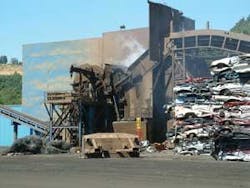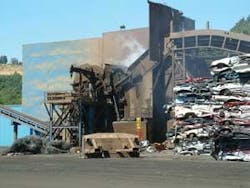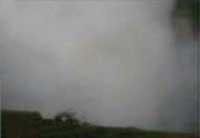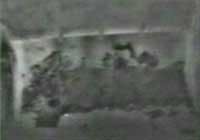Infrared imaging helps shred scrap cars
Using an off-the-shelf infrared camera system to monitor the intake chute of a scrap-metal shredder increases throughput and reduces downtime.
By Lawrence H. Brown
As mass production of automobiles escalated in the USA during the first half of the 20th century, the standard methods of processing junk cars-either torching them by hand or shearing them with large hydraulic equipment--became untenable. The growing problem of junkyards filling with discarded vehicles, coupled with the need from steel mills for better-quality scrapped ferrous metal, led to the creation of the metal shredder.
Metal shredders first began to operate in the mid- to late-1960s. Although they were designed with feed-roll devices to control the rates at which cars and appliances were fed into them, monitoring the intake feed to the shredder-the heart of the operation-was a constant battle. Situated outdoors, the material is loaded onto a conveyor and carried 175 ft or more to an intake chute. The chute feeds the metal to a toothed drum that pushes it into the mouth of a 30-foot-high, 7000-horsepower shredder (see Fig. 1). As it shreds the metal, water is injected into the shredder at rates as high as 11 gallons per minute to keep the metal cool and to displace oxygen content, as gas residue and vapors from tanks and engines can readily ignite.
But cooling the metal creates dense steam, smoke, and fog, preventing the operator, who sits in a control tower behind bullet-proof glass and oversees the entire operation, from seeing and controlling the intake stream as it’s conveyed to the shredder (see Fig. 2). In addition, metal shredding often is done at night (when electricity rates are lower), making visual monitoring even more difficult.
The introduction of programmable logic controllers (PLCs) in the 1980s to monitor and control the amperage of the conveyor and feed-roll motors was helpful but not a solution. “The operator still needs to see how much material is in the intake chute,” explains Mike Kalinowski, design engineer and project manager at Texas Shredder, which helps design and build shredders worldwide. “Otherwise it’s just an educated guess as to how much (material) is going into the shredder at any time.”
The inability to visually monitor the material in the intake chute had been a long-standing problem. Continuous feeding to the shredder is extremely important for a steady production rate. Lacking the vision necessary to see tonnage as it is pushed into the shredder causes jamming of the machines, leading to frequent shutdowns and damage to the equipment. Once shut down, workers have to dig out the jammed metal from the shredder’s mouth using cutting torches and pry bars.
SEEING THROUGH SMOKE
“A typical shutdown can last anywhere from one to eight hours,” explains Kalinowski. The lost time and decreased productivity pushed engineers to find a solution, eventually solving the problem by using infrared (IR) cameras to see through the smoke and fog.
Infrared cameras, preprogrammed to point and shoot, can scan and interpret the images inside the smoke. Mounted 15 ft above the mouth of the shredder for continuous scanning of the intake feeder and the shredder, the camera sends the IR images for display to a color monitor in the control tower, where the operator checks for any signs of jamming.
Texas Shredder uses the FLIR Systems A20V IR camera. “The camera is designed to operate unattended for long periods in harsh industrial environments,” explains Paul Czerepuszko, an engineer and OEM development manager at FLIR. “It also provides real-time thermal images.”
Remote access is provided through Ethernet or FireWire connectivity to a laptop in the control tower. “This lets the operator change the parameters in the camera such as the color palette settings,” says Czerepuszko.
“The camera is usually mounted to an existing structure,” says Kalinowski, “and can be placed flat or upside down, depending on site conditions such as the location of the tower in relation to the shredder.” When positioning the camera directly above the metal shredder, it must be protected from the harsh environment. Only one camera is needed at a site, with its target area set in the spectral range of 7.5 to 13 µm. It is set in a steel housing to shield it from the high heat, water, metal projectiles, and explosions.
Infrared images do not transmit through glass or plastic, and, as part of the protective housing, a transmissive glass, supplied by Hawk-IR, is placed in front of the camera lens. The housing is protected by a stainless-steel screen, and compressed air is used to keep the camera cooled. The air is sourced from the motor-control room, located beneath the control tower, and piped directly into the protective steel housing. A flexible air line is used for the last 5 ft of pipe leading to the camera to isolate vibrations.
A metal tube, inserted in the protective housing, releases the air and blows it on the lens cover to tap off the air compression that builds up inside the steel housing and to clear the protective lens from dust and dirt. At some sites, fans are mounted near the camera with the air currents blown directly on it.
LOGIC CONTROLS
In the control tower, the operator monitors the conveyor, feed rolls, and shredder motor, in addition to the continuous IR scan. PLCs from Allen-Bradley, Rockwell Automation, monitor the amperage of each and relay the data to a touch screen that is continually checked for updates. If the amperage is too high on the conveyor, for example, the PLC Windows-based program, called Auto Pilot, slows or stops the system. The touch screen is alarmed with icons that appear and light up when the PLCs detect a fault and send a descriptive error message.
A second program, Hawkeye from Smart Recycling Solutions, also Windows-based, collects and archives data for the load demand of the motors. Screen icons display most common shredder problems, such as blocked in-feed rollers, a gap in feed, or material that cannot be shredded. Hawkeye identifies the specific problem and will not let the operator continue until it is corrected. However, the operator can override the system on an as-needed basis.
Among the major improvements to the operation include an increase in the motor operating efficiency. “A more stable thermal motor temperature is maintained,” reports Jeff Shaffrath, director of operations at Schnitzer Steel.
Most who use the system report at least some increase in output tonnage and reductions in operating costs. Operators and engineers praise the increased safety and reduced downtime that using infrared cameras has given them.
“The machines still get jammed on occasion, but not nearly with the regularity that they did before we started to use the infrared system,” Kalinowski reports.
FLIR systems, N. Billerica, MA, USA www.flirthermography.com
Hawk-IR, Marske-by-sea, UK www.hawk-ir.com
Rockwell Automation (Allen-Bradley & Rockwell Software Brands). Milwaukee, WI, USA www.ab.com
Schnitzer Steel, Tacoma, WA, USA www.schnitzersteel.com
Smart Recycling Solutions/TSI, Grays, Essex, UK
Texas Shredder, San Antonio, TX, USA www.texasshredder.com
Lawrence H. Brownis senior techincal writer, FLIR Systems, N. Billerica, MA, USA; www.flirthermography.com.



